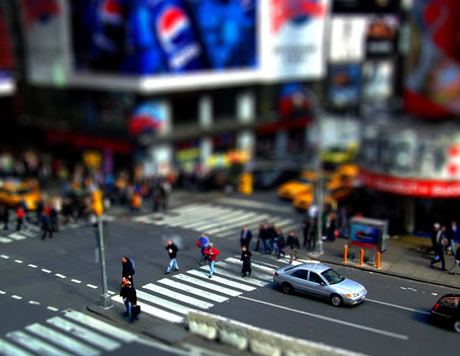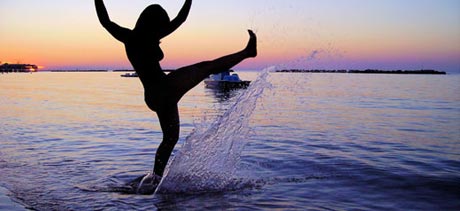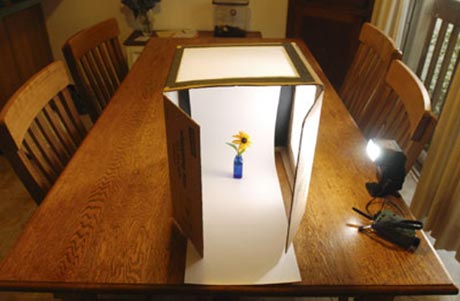 One of my favorite effects for an image is the tilt-shift effect. It makes an ordinary image appear as though it is a miniature model, as the photo of Times Square in NY above shows. Tilt-Shift Photography has a great tutorial to show you how to turn your image into a tilt-shift masterpiece, using just the tools built-in to Photoshop. Keep in mind that you want to give the impression of a miniature model. Miniature models are usually viewed from above so try and choose a photo with an elevated viewpoint.
One of my favorite effects for an image is the tilt-shift effect. It makes an ordinary image appear as though it is a miniature model, as the photo of Times Square in NY above shows. Tilt-Shift Photography has a great tutorial to show you how to turn your image into a tilt-shift masterpiece, using just the tools built-in to Photoshop. Keep in mind that you want to give the impression of a miniature model. Miniature models are usually viewed from above so try and choose a photo with an elevated viewpoint.
Tagged: Photography
Master your DSLR camera – program mode
You ponied up for a digital SLR camera because you hated the shutter lag on your little point-and-shoot. The good news: Your photos have improved! The bad news? You know they could be even better—if only you dared to let go of the camera’s “auto” mode. It’s as if you’ve been creeping around the neighborhood in a new Mustang using only first gear. No more! It’s time to take control, hit the highway, and learn what you can do in program mode. Lifehacker has a great feature titled Master Your DSLR Camera: Program Mode — worth taking a look at if you have a digital camera and you’re not yet used to the settings.
How to avoid flash blow out in your digital photos
You’ve been in the situation. You’re up close to your subject in a low-light situation, you take the picture and the flash goes off. It’s a once-in-a-lifetime shot – but when you check the photo, it’s completely washed out and white from the flash. Digital Photography School has 7 Strategies for Avoiding Flash Blow Out in your digital photos. One of the techniques I really love using is #4 on their list, commonly referred to on digital cameras is “night mode.” This mode uses a technique called slow sync flash, where the camera shutter stays open a little longer to allow more light in, and then the flash goes off at the beginning or end of the shot. This method allows you to allow more ambient light from the background, while still freezing the action when the flash goes off. The technique can produce stunning results.
Digital photography tip roundup
Digital Photography School has posted a roundup of digital photography tips from around the Web, as well as a few great ones of their own. Among those is a great breakdown of some popular DSLR lenses, and how to take great group photos. If you’re shooting your own photos for ads, or you are just getting into digital photography as a hobby, Digital Photography School is a great resource.
How to Photograph Silhouettes in 8 Easy Steps
 Digital Photography School has a brief tutorial on photographing silhouettes available that may help you in your creative photography. The silhouette technique can be quite stunning when used in ads & other collateral materials . Of course, having the right subject matter always makes a big difference.
Digital Photography School has a brief tutorial on photographing silhouettes available that may help you in your creative photography. The silhouette technique can be quite stunning when used in ads & other collateral materials . Of course, having the right subject matter always makes a big difference.
DIY lightbox for better digital photography
 Strobist shows you how to build a light box for shooting perfectly-lit close-up items for all you digital photographers on the cheap. I particularly like this one as it’s something I’ve often done myself. The only real expense is a large piece of white poster board, a cardboard box, some tissue paper (or tracing paper), some tape, scissors and some lights (any lamps or bright lights will probably do the trick).
Strobist shows you how to build a light box for shooting perfectly-lit close-up items for all you digital photographers on the cheap. I particularly like this one as it’s something I’ve often done myself. The only real expense is a large piece of white poster board, a cardboard box, some tissue paper (or tracing paper), some tape, scissors and some lights (any lamps or bright lights will probably do the trick).
Tips for digital photography beginners
 If you’re new to digital photography (welcome aboard!), Canon has a nifty little site that discusses all the basics about your digital camera (regardless of the brand) and how to take great pictures. Some of the topics covered are:
If you’re new to digital photography (welcome aboard!), Canon has a nifty little site that discusses all the basics about your digital camera (regardless of the brand) and how to take great pictures. Some of the topics covered are:
- Bright & dark shots
- Controlling depth of field
- Freezing or blurring motion
- ISO speed effects
- Creating depth
- Setting image quality
- Focusing a moving subject
- Shooting dark subjects
- Shooting bright colors
- Using white balance
Again, this site is mostly for beginners, but there may be some interesting tips for hobbiests who simply refuse to read their camera manual! 
